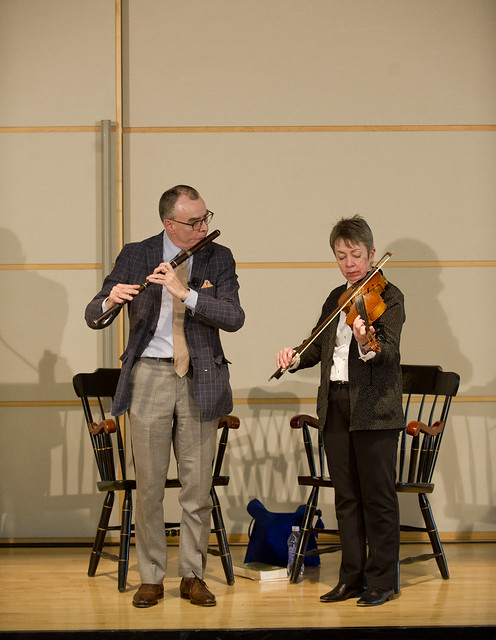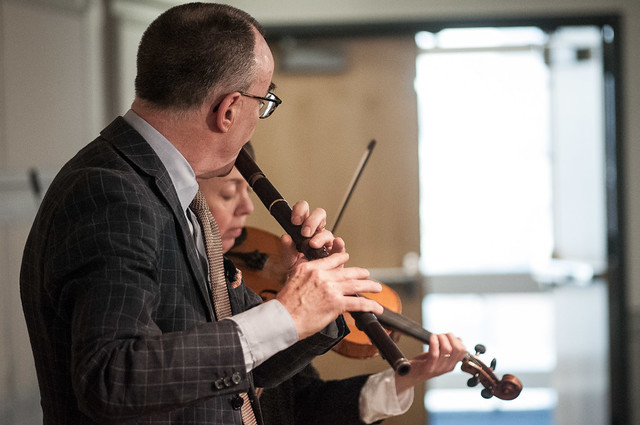Event Highlights: Irish Voices – A Celebration of Poetry and Music with Ciarán Carson
On April 8, 2013, continuing our “Irish Voices” series, we welcomed the Irish poet and novelist Ciarán Carson to Boston. Carson, who plays the tin whistle, was accompanied by his wife Deirdre Shannon, an accomplished fiddler. The event, which was funded largely by a grant from the European Commission Delegation in Washington to the Center for the co-sponsored by the Center for the Study of Europe, was co-sponsored by the Center for the Humanities, the new Institute for the Study of Irish Culture, the literary journal AGNI, and the Department of Creative Writing at Boston University. Vivien Schmidt, Jean Monnet Professor of European Integration and Director of the Center for the Study of Europe, gave the opening remarks, and Meg Tyler, poet, professor, and Director of the Institute for the Study of Irish Culture, introduced Ciarán Carson and moderated the event.
Carson was born in Belfast, Northern Ireland, in 1948, into an Irish speaking family. His collections of poetry include The Irish for No (1987), winner of the Alice Hunt Bartlett Award; Belfast Confetti (1990), which won the Irish Times Irish Literature Prize for Poetry; and First Language: Poems (1994), winner of the T.S. Eliot Prize. His volume Breaking News (2003) won the Forward Poetry prize; his poetry collection For All We Know (2008) was short listed for the T.S. Eliot Prize and the Coastal Poetry Award; and Until Before After (2010) was short listed for the 2011 Irish Times Poetry Award. Carson is also an avid translator (producing translations of Rimbaud, Baudelaire, Mallarmé, and Dante), an adept prose writer, and an accomplished musician. His prose works include Last Night’s Fun: About Music, Food and Time (1997), a study of Irish traditional music, and his translations include The Táin (2009), the legendary early Irish tale.
As Tyler described it in her introductory remarks, “Carson’s work is bound inextricably to his home city of Belfast, its history, its topography, its place names, and to Irish music, the improvisational quality of which influences much of his work, as in Sean-nós, Irish for “old style,” a highly ornamented style of unaccompanied traditional Irish singing. In his poems, you find patterns of ornamentation and moments of melodic freedom. His poems are dense with literary reference and other kinds of linguistic association. ‘Ode to a Nightingale’ and onomatopoeia sound out in his pages. If you look closely enough, connections, and patterns between colors, forms, sounds, and even smells emerge.”
Carson read a number of his poems, including some of his recent translations from Rimbaud. His reading was interspersed with commentary – he described learning English at the age of four, on the streets of Belfast, the dream-vision nature of the “aisling,” and the “elsewhereness” of translation – and also music, underscoring the melodic quality of Carson’s work, a quality he said he strives to achieve in his prose as well. Not by use of flowery language, but by a certain attentiveness to how the words sound. He mentioned Raymond Carver as an example of someone using “plain ordinary language” that sings in its own “flat, eery, odd way.”
Perhaps the most interesting part of the evening was the discussion of “form” that ensued from Tyler’s query into the “formal challenges” Carson has been setting for himself over the years. Carson said that adherence to form (imitating Dante’s Terza Rima, for example) pushes him to new levels of meaning and understanding that he would not reach if he were able to settle for more obvious word choices, etc. There are ideas we stumble on, haphazardly at times, only through form.
Be sure to catch this enchanting evening on BUniverse.


